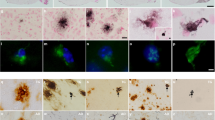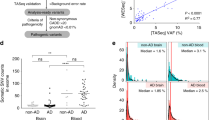Abstract
Familial forms of frontotemporal dementias are associated with mutations in the tau gene. A kindred affected by progressive subcortical gliosis (PSG), a rare form of presenile dementia, has genetic linkage to chromosome 17q21-22 (refs. 1,2, 3). This kindred (PSG-1) is included in the 'frontotemporal dementias and Parkinsonism linked to chromosome 17' group along with kindreds affected by apparently different forms of atypical dementias4. Some of these kindreds have mutations in the tau gene5,6,7,8,9,10. We report here that PSG-1 has a tau mutation at position +16 of the intron after exon 10. The mutation destabilizes a predicted stem–loop structure and leads to an over-representation of the soluble four-repeat tau isoforms, which assemble into wide, twisted, ribbon-like filaments and ultimately result in abundant neuronal and glial tau pathology. The mutations associated with PSG and other atypical dementias can be subdivided into three groups according to their tau gene locations and effects on tau. The existence of tau mutations with distinct pathogenetic mechanisms may explain the phenotypic heterogeneity of atypical dementias that previously led to their classification into separate disease entities.
This is a preview of subscription content, access via your institution
Access options
Subscribe to this journal
Receive 12 print issues and online access
$209.00 per year
only $17.42 per issue
Buy this article
- Purchase on Springer Link
- Instant access to full article PDF
Prices may be subject to local taxes which are calculated during checkout



Similar content being viewed by others
References
Neumann, M.A. & Cohn, R. Progressive subcortical gliosis, a rare form of presenile dementia. Brain 90, 405–427 (1967).
Lanska, D.J. et al. Familial progressive subcortical gliosis. Neurology 44, 1633–1643 ( 1994).
Petersen, R.B. et al. Familial progressive subcortical gliosis: Presence of prions and linkage to chromosome 17. Neurology 45, 1062–1067 (1995).
Foster, N.L. et al. Frontotemporal dementia and Parkinsonism linked to chromosome 17: A consensus conference. Ann. Neurol. 41, 706–715 (1997).
Spillantini, M.G., Bird, T.D. & Ghetti, B. Frontotemporal dementia and Parkinsonism linked to chromosome 17. A new group of tauopathies. Brain Pathol. 8, 387–402 (1998).
Poorkaj, P. et al. Tau is a candidate gene for chromosome 17 frontotemporal dementia. Ann. Neurol. 43, 815–825 (1998).
Hutton, M. et al. Association of missense and 5' -splice-site mutations in tau with the inherited dementia FTDP-17. Nature 393, 702–705 (1998).
Spillantini, M.G. et al. Mutation in the tau gene in familial multiple system tauopathy with presenile dementia. Proc. Natl. Acad. Sci. USA 95, 7737–7741 (1998).
Dumanchin, C. et al. Segregation of a missense mutation in the microtubule-associated protein tau with frontotemporal dementia and parkinsonism. Hum. Mol. Genet. 7, 1825–1829 (1998).
Clark, L.N. et al. Pathogenic implications of mutations in the tau gene in pallido-ponto-nigral degeneration and related neurodegenerative disorders linked to chromosome 17. Proc. Natl. Acad. Sci. USA 95, 13103 –13107 (1998).
Gambetti, P. Prion in progressive subcortical gliosis revisited. Neurology 49, 309–310 (1997).
Dickson, D.W. in Astrocytes in Brain Aging and Neurodegeneration (ed., Schipper, H.M.) 165–188 (R.G. Landes, Austin, Texas, 1998).
Goedert, M., Spillantini, M.G., Jakes, R., Rutherford, D. & Crowther, R.A. Multiple isoforms of human microtubule-associated protein tau: Sequences and localization in neurofibrillary tangles of Alzheimer's disease. Neuron 3, 519– 526 (1989).
Goedert, M., Spillantini, M.G., Potier, M.C., Ulrich, J. & Crowther, R.A. Cloning and sequencing of the cDNA encoding an isoform of microtubule-associated protein tau containing four tandem repeats: Differential expression of tau mRNAs in human brain. EMBO J. 8, 393–399 (1989).
Andreadis, A., Brown, M.W. & Kosik, K.S. Structure and novel exons of the human tau gene. Biochemistry 31, 10626–10631 (1992).
Hong, M. et al. Mutation-specific functional impairments in distinct tau isoforms of hereditary FTDP-17. Science 282, 1914 –1917 (1998).
Hasegawa, M., Smith, M.J., Iijima, M., Tabira, T. & Goedert, M. FTDP 17 mutations N279K and S305N in tau produce increased splicing of exon 10. FEBS Lett. 443, 93– 96 (1999).
Hasegawa, M., Smith, M.J. & Goedert, M. Tau proteins with FTDP-17 mutations have a reduced ability to promote microtubule assembly. FEBS Lett. 437, 207–210 (1998).
Spillantini, M.G., Crowther, R.A., Kamphorst, W., Heutink, P. & van Swieten, J.C. Tau pathology in two Dutch families with mutations in the microtubule-binding region of tau. Am. J. Pathol. 153, 1359–1363 (1998).
Goedert, M., Crowther, R.A. & Spillantini, M.G. Tau mutations cause frontotemporal dementias. Neuron 21, 955–958 ( 1998).
Crowther, R.A. Structural aspects of pathology in Alzheimer's disease. Biochim. Biophys. Acta 106, 1–9 ( 1991).
Spillantini, M.G. et al. Familial multiple system tauopathy with presenile dementia: A disease with abundant neuronal and glial tau filaments. Proc. Natl. Acad. Sci. USA 94, 4113–4118 (1997).
Goedert, M., Spillantini, M.G., Cairns, N.J. & Crowther, R.A. Tau proteins of Alzheimer paired helical filaments: Abnormal phosphorylation of all six brain isoforms. Neuron 8, 159 –168 (1992).
Goedert, M. & Jakes, R. Expression of separate isoforms of human tau protein: Correlation with the tau pattern in brain and effects on tubulin polymerization. EMBO J. 9, 4225– 4230 (1990).
Crowther, R.A. Straight and paired helical filaments in Alzheimer disease have a common structural unit. Proc. Natl. Acad. Sci. USA 88, 2288 –2292 (1991).
Acknowledgements
The authors wish to thank R. Currier for providing the PSG 1 family and making autopsy tissue available, and D. Kofskey for technical assistance. Support for this work was provided by grants from the US National Institute of Health and by the Britton Fund as well as by the UK Medical Research Council (M.G., M.G.S. and R.A.C.), the Metropolitan Life Foundation (M.G.) and The Royal Society of London (M.G.S.).
Author information
Authors and Affiliations
Rights and permissions
About this article
Cite this article
Goedert, M., Spillantini, M., Crowther, R. et al. Tau gene mutation in familial progressive subcortical gliosis . Nat Med 5, 454–457 (1999). https://doi.org/10.1038/7454
Received:
Accepted:
Issue Date:
DOI: https://doi.org/10.1038/7454
This article is cited by
-
Recent origin and spread of a common Welsh MAPT splice mutation causing frontotemporal lobar degeneration
neurogenetics (2009)
-
Complex disease-associated pharmacogenetics: drug efficacy, drug safety, and confirmation of a pathogenetic hypothesis (Alzheimer's disease)
The Pharmacogenomics Journal (2007)
-
The many ways to frontotemporal degeneration and beyond
Neurological Sciences (2007)
-
An immunohistochemical study of cases of sporadic and inherited frontotemporal lobar degeneration using 3R- and 4R-specific tau monoclonal antibodies
Acta Neuropathologica (2006)



